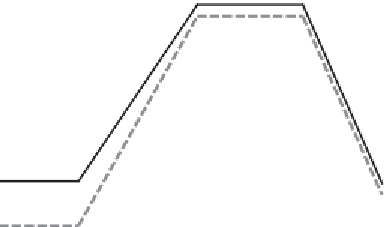Geoscience Reference
In-Depth Information
K
c
=
K
cb
+
K
e
1.4
1.2
K
e
1.0
0.8
0.6
0.4
K
cb
0.2
0.0
Initial
Crop development
Mid-season
Late season
Time
Figure 8.3
Crop coeficient curves showing the basal
K
cb
, soil evaporation
K
e
and the
corresponding single
K
c
=
K
cb
+
K
e
curves.
Dual Crop Coeficient
One of the main disadvantages of the single-crop coeficient is that two processes
(transpiration and soil evaporation) have to be covered by one crop coeficient. After
all, the relationship between actual soil evaporation and
E
ref
has nothing to do with
plant characteristics. Therefore Allen et al. (
1998
) proposed to use for more accurate
and detailed studies (e.g., studies on daily basis) dual-crop coeficients:
(
)
EK KE
=+
ref
(8.2)
cb
e
where
K
cb
is the basal crop factor and
K
e
the soil evaporation coeficient.
K
cb
is
deined as the ratio
E
/
E
ref
when the soil surface is dry.
K
e
describes the evaporation
component of
E
.
Figure 8.3
illustrates the methodology. The value of
K
cb
is smaller
than the value of
K
c
in
Figure 8.2
because the latter includes the average soil evap-
oration. If the soil is wet following rain or irrigation
K
e
may be large. However, the
sum of
K
cb
and
K
e
can never exceed a maximum value as determined by the total
energy amount available for evapotranspiration.
K
e
decreases sharply when the top
soil dries out. The corresponding smoothed
K
c
(i.e.,
K
cb
+
K
e
) curve is also shown in
Figure 8.3
and illustrates the effect of averaging
K
cb
and
K
e
over time. The estima-
tion of
K
e
requires a daily water balance computation for the water content in the
top soil. Allen et al. (
1998
) describe in detail the procedure to determine both
K
cb
and
K
e
. Compared to the single-crop coeficient approach, the dual-crop coeficient
approach is more suitable to analyse daily irrigation scheduling or other research
studies in which daily variations in soil surface wetness affect evapotranspiration
and soil water luxes.













































































































































































































































































































































































































































Search WWH ::

Custom Search